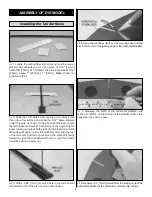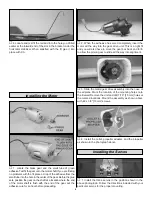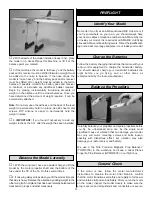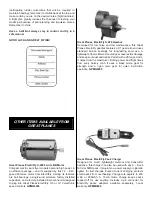
❏
7. With the horizontal stabilizer placed bottom up on a flat
surface, place the tail boom (with the bracket attached) on
top of the stabilizer as shown in the above photographs with
the rear of the assembled tail boom positioned on the
centerline and the 3/16" [5mm] mark. Make the correct
alignment by measuring the distance from the tip of the tail
boom to both forward corners of the horizontal stab. Make
the necessary adjustments until both measurements are
equal on both sides.
❏
8. When you are satisfied with the correct position of the tail
boom, mark the position of the bracket onto the stabilizer.
❏
9. Using a sharp hobby knife cut away the covering just
inside the lines you drew on the covering. Do not cut into the
balsa as this will weaken the structure. Glue the tail boom
into place with CA. While the glue cures check the
positioning with a ruler in the same way as when you
marked the location.
❏
10. Cut a slot into the right elevator at a point 3/16"
[5mm] toward the outer end of the elevator from the inside
edge of the elevator. Place the control horn into the slot in a
manner that allows the holes in the horn to align with the
hinge line as shown in the above photograph. Make sure
that the horn is placed on top of the elevator. When you are
satisfied with the placement, glue it into place with CA.
❏
11. Place the fin/rudder into the slot on top of the horizontal
stabilizer. Use a felt-tipped pen and mark the position on both
the fin and the stabilizer as shown in the photograph above.
❏
12. Using the same procedure as before, cut the covering
away from the top of the stabilizer as shown in the
photograph above. Do the same with the base of the fin
where you made the marks. Before gluing the fin/rudder into
place in the next step, position the control horn for the
rudder into the left side of the rudder and glue the control
horn into place with CA.
7


































